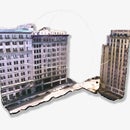Introduction: 3D Light Painting
This project was conceived the night of halloween. Looking out the window on the frozen streets of Chicago, looking at the lights on the street reflect on the pavement, looking so far beyond that the lights of the passing cars would float in the air long after the car was gone.
Many of us are familiar with light painting, moving a flashlight in the darkness and letting a camera take a long exposure photograph. Most of us who have done it know how fun it can be, tracing invisible messages and letting the camera decoded them. If you don't yet know what I'm talking about check out Buenoben work, he has a great instuctable explaining how he did his amazing video.
It all made me wonder, how would this look in 3D controlled by robots, creating the complex geometry of a 3D model instead of it all being freehand?
Step 1: Looking Into My Box of Forgotten Goods
Fascinated by this idea I started looking for parts, things that I had plan to use in the past but now were just waiting to be used inside a box. After doing a quick inventory I did a shopping trip to buy the parts I would need; just simple things like longer cables and four spools of fishing lines. Since the beginning I realized that I would need to control the light, being able to turn it on or off on command. The original idea was to run a cable to the light, but I soon realized that wasn't going to look good and it could even cause problems while trying to move the light.
I thought of ways to do this wirelessly, perhaps having an arduino nano on board with the light and a bluetooth shield, perhaps using a xbee radio... I realized there was a significantly simpler solution. On my way back from the hardware store I stopped by a toys r us looking for small RC toys and I found this relatively cheap robot that would use an infrared controller.
Step 2: 3D Printing...
In order to keep the fishing line coiled on the spool I needed something to keep it aligned, no mater where everything else was moving so I designed this quick threads aligners that would attach to the motor mount. I also ended up 3D printing my own spools because the off the shelfs ones where giving me lots of problems.
*Not sure how to make the .STL work
Step 3: Mounting Everything
I realized that I skipped a couple of steps here, before mounting I solder all the wires to the motors as well as all the wires to the motor drivers, I used sparkfun's Big Easy Drivers just because I had some laying around. None the less I like this ones better than the easydriver I have tried before.
To mount everything I used a step ladder to reach and zip ties to attach to exciting conduits. I didn't want to drill holes and damage someone else's ceiling.
Step 4: First Testings
At first I started with simple movements, making the four motors going down in synchrony, then I started moving towards the sides exploring the limits and the way everything came together.
Step 5: Sending Points
It was now time to make this a little more automated. At the beginning it was still pretty manual, I wrote the points I wanted the machine to move towards in excel and then translated the coordinates into rotations for each individual motor. This process turned out to be a lot harder than I was anticipating for and my first cube tests look a little distorted. Using a 3D graphing calculator I plotted the points to make sure I made no mistakes while choosing the points I wanted to go to, this helped a lot to double check my work.
Step 6: Making a Cube That Looks Like a Cube
After realizing that my initial math had some problems and fixing them things started looking much better!
Step 7: Future... Coming Soon!
In the future I see this as being able to draw 3d models, so I started working on some processing code to break a model into points and then trace lines between the points. It is not quite ready for prime time yet.
Hopefully soon!








